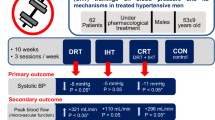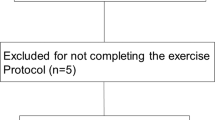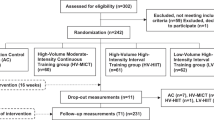Abstract
This study investigated the effects of dynamic resistance exercise (DRE), isometric handgrip exercise (IHE) and combined resistance exercise (DRE+IHE) on post-exercise hypotension (PEH) and its hemodynamic, autonomic, and vascular mechanisms. For that, 70 medicated hypertensives men (52 ± 8 years) were randomly allocated to perform one of the following interventions: DRE (3 sets, 8 exercises, 50% of 1RM), IHE (4 sets, 2 min, 30% of MVC), CRE (DRE+IHE) and control (CON, seated rest). Before and after the interventions, blood pressure (BP), systemic hemodynamics, cardiovascular autonomic modulation and brachial vascular parameters were evaluated. After the DRE and CRE, systolic and mean BP decreased (SBP = −7 ± 6 and −8 ± 8 mmHg; MBP −4 ± 5 and −5 ± 5 mmHg, respectively, all P < 0.05), vascular conductance increased (+ 0.47 ± 0.61 and +0.40 ± 0.47 ml.min−1.mmHg−1, respectively, both P < 0.05) and baroreflex sensitivity decreased (−0.15 ± 0.38 and −0.29 ± 0.47 ms/mmHg, respectively, both P < 0.05) in comparison to pre-exercise values. No variable presented any significant change after IHE. The responses observed after CRE were similar to DRE and significantly different from CON and IHE. In conclusion, DRE, but not IHE, elicits PEH, which happens concomitantly to skeletal muscle vasodilation and decreased baroreflex sensitivity. Moreover, adding IHE to DRE does not potentiate PEH and neither changes its mechanisms.
Clinical Trial Registration: Data from this study derived from an ongoing longitudinal clinical trial approved by the Institution’s Ethics Committee of Human Research (process 2.870.688) and registered at the Brazilian Clinical Trials (RBR-4fgknb) at http://www.ensaiosclinicos.gov.br.
This is a preview of subscription content, access via your institution
Access options
Subscribe to this journal
Receive 12 digital issues and online access to articles
$119.00 per year
only $9.92 per issue
Buy this article
- Purchase on Springer Link
- Instant access to full article PDF
Prices may be subject to local taxes which are calculated during checkout


Similar content being viewed by others
Data availability
Final study data is available by written request to the investigators.
References
Mills KT, Bundy JD, Kelly TN, Reed JE, Kearney PM, Reynolds K, et al. Global disparities of hypertension prevalence and control. Circulation. 2016;134:441–50.
Lawes CM, Hoorn SV, Rodgers A. Global burden of blood-pressure-related disease, 2001. Lancet. 2008;371:1513–8.
MacDonald HV, Johnson BT, Huedo‐Medina TB, Livingston J, Forsyth KC, Kraemer WJ, et al. Dynamic Resistance Training as Stand‐Alone Antihypertensive Lifestyle Therapy: A Meta-Analysis. J Am Heart Assoc. 2016;5:e003231.
Whelton PK, Carey RM, Aronow WS, Ovbiagele B, Casey DE, Smith SC, et al. ACC / AHA / AAPA / ABC / ACPM / AGS / APhA / ASH / ASPC / NMA / PCNA Guideline for the Prevention, Detection, Evaluation, and Management of High Blood Pressure in Adults A Report of the American College of Cardiology / American Heart Association T. Hypertension. 2018;71:1269–324.
Williams B, Mancia G, Spiering W, Rosei E, Azizi M, Burnier M. ESC/ESH Guidelines for the management of arterial hypertension. J Hypertens. 2018;36:1953–2041.
Brito LC, Fecchio RY, Peçanha T, Andrade-Lima A, Halliwill JR, Forjaz CLM. Postexercise hypotension as a clinical tool: a “single brick” in the wall. J Am Soc Hypertens. 2018;12:e59–e64.
Kenney MJ, Seals DR. Postexercise hypotension. Key features, mechanisms, and clinical significance. Hypertens (Dallas, Tex 1979). 1993;22:653–64.
Tibana RA, de Sousa NMF, da Cunha Nascimento D, Pereira GB, Thomas SG, Balsamo S, et al. Correlation between Acute and Chronic 24-Hour Blood Pressure Response to Resistance Training in Adult Women. Int J Sports Med. 2014;36:82–89.
Moreira SR, Cucato GG, Terra DF, Ritti-Dias RM. Acute blood pressure changes are related to chronic effects of resistance exercise in medicated hypertensives elderly women. Clin Physiol Funct Imaging. 2016;36:242–8.
Casonatto J, Goessler KF, Cornelissen VA, Cardoso JR, Polito MD. The blood pressure-lowering effect of a single bout of resistance exercise: A systematic review and meta-analysis of randomised controlled trials. Eur J Prev Cardiol. 2016;23:1700–14.
Queiroz ACC, Sousa JCS, Cavalli AAP, Silva ND Jr, Costa LAR, Tobaldini E, et al. Post-resistance exercise hemodynamic and autonomic responses: Comparison between normotensive and hypertensive men. Scand J Med Sci Sport. 2015;25:486–94.
Hardy DO, Tucker LA. The effects of a single bout of strength training on ambulatory blood pressure levels in 24 mildly hypertensive men. Am J Health Promot. 1998;13:69–72.
Rezk CC, Marrache RCB, Tinucci T, Mion D, Forjaz CLM. Post-resistance exercise hypotension, hemodynamics, and heart rate variability: Influence of exercise intensity. Eur J Appl Physiol. 2006;98:105–12.
Brito AF, de Oliveira CVC, Santos MSB, Santos AC. The effects of a single bout of strength training on ambulatory blood pressure levels in 24 mildly hypertensive men. Clin Physiol Funct Imaging. 2014;34:126–32.
Collier S, Diggle M, Heffernan K, Kelly E, Tobin M, Fernhall B. Changes in arterial distensibility and flow-mediated dilation after acute resistance vs. aerobic exercise. J Strength Cond Res / Natl Strength Cond Assoc. 2010;24:2846–52.
Queiroz ACC, Sousa JCS, Silva ND, Tobaldini E, Ortega KC, De Oliveira EM, et al. Captopril does not Potentiate Post-Exercise Hypotension: A Randomized Crossover Study. Int J Sports Med. 2017;38:270–7.
Souza LR, Vicente JB, Melo GR, Moraes VC, Olher RR, Sousa IC, et al. Acute Hypotension after Moderate-Intensity Handgrip Exercise in Hypertensive Elderly People. J Strength Cond Res. 2018;32:2971–7.
Olher RRV, Bocalini DS, Bacurau RF, Rodriguez D, Figueira A, Pontes FL, et al. Isometric handgrip does not elicit cardiovascular overload or post-exercise hypotension in hypertensive older women. Clin Interv Aging. 2013;8:649–55.
van Assche T, Buys R, de Jaeger M, Coeckelberghs E, Cornelissen VA. One single bout of low-intensity isometric handgrip exercise reduces blood pressure in healthy pre- and hypertensive individuals. J Sports Med Phys Fitness. 2017;57:469–75.
Ash GI, Taylor BA, Thompson PD, MacDonald HV, Lamberti L, Chen MH, et al. The antihypertensive effects of aerobic versus isometric handgrip resistance exercise. J Hypertens. 2016;35:291–9.
Goessler K, Buys R, Cornelissen VA. Low-intensity isometric handgrip exercise has no transient effect on blood pressure in patients with coronary artery disease. J Am Soc Hypertens. 2016;10:633–9.
Millar PJ, MacDonald MJ, Bray SR, McCartney N. Isometric handgrip exercise improves acute neurocardiac regulation. Eur J Appl Physiol. 2009;107:509–15.
Teixeira AL, Ritti-Dias RM, Antonino D, Bottaro M, Millar PJ, Vianna LC. Sex Differences in Cardiac Baroreflex Sensitivity following Isometric Handgrip Exercise. Med Sci Sport Exerc 2017;1:770-7.
Queiroz ACC, Rezk CC, Teixeira L, Tinucci T, Mion D, Forjaz CLM. Gender influence on post-resistance exercise hypotension and hemodynamics. Int J Sports Med. 2013;34:939–44.
Esformes J, Norman F, Sigley J, Birch K. The influence of menstrual cycle phase upon postexercise hypotension. Med Sci Sports Exerc. 2006;38:484–91.
de Freitas VH, Mariano IM, Amaral AL, Rodrigues ML, Carrijo VHV, Nakamura FY, et al. Blood Pressure and Heart Rate Variability Responses to High-Intensity Interval Training in Untrained Postmenopausal Women. Res Q Exerc Sport. 2022;93:749–57.
Matias LAS, Mariano IM, Batista JP, De Souza TCF, Amaral AL, Dechichi JGC, et al. Acute and chronic effects of combined exercise on ambulatory blood pressure and its variability in hypertensive postmenopausal women. Chin J Physiol. 2020;63:227–34.
Malachias M, Souza W, Plavnik F, Rodrigues C, Brandão AA, Neves MFT, et al. 7a Diretriz Brasileira de Hipertensão Arterial. Arq Bras Cardiol. 2016;107:1–83.
Fecchio RY, de Sousa JCS, Oliveira-Silva L, da Silva Junior ND, Pio-Abreu A, da Silva GV, et al. Effects of dynamic, isometric and combined resistance training on blood pressure and its mechanisms in hypertensive men. Hypertens Res. 2023;11:1031–43.
Maud PJ, Foster C Physiological Assessment of Human Fitness. 1st ed. Human Kinetics: Champaign, IL, 1995 https://doi.org/10.1097/00005768-199607000-00027.
Carlson DJ, Inder J, Palanisamy SKA, McFarlane JR, Dieberg G, Smart NA. The efficacy of isometric resistance training utilizing handgrip exercise for blood pressure management: A randomized trial. Medicine (Baltimore). 2016;95:e5791.
Jones N, Campbell E, McHardy G, Higgs B, Clode M. The estimation of carbon dioxide pressure of mixed venous blood during exercise. Clin Sci. 1967;32:311–27.
Fecchio RY, Brito LC, Peçanha T, Forjaz CLM. Post-exercise hypotension and its hemodynamic determinants depend on the calculation approach. J Hum Hypertens. 2020;34:719–26.
European Society of Cardiology; North American Society of Pacing and Electrophysiology. Heart rate variability. Standards of measurement, physiological interpretation, and clinical use. Task Force of the European Society of Cardiology and the North American Society of Pacing and Electrophysiology. Eur Heart J. 1996;17:354–81.
Thijssen DHJ, Bruno RM, van Mil ACCM, Holder SM, Faita F, Greyling A et al. Expert consensus and evidence-based recommendations for the assessment of flow-mediated dilation in humans. Eur Heart J .2019;40:2534–47.
Fecchio RY, Chehuen M, Brito LC, Peçanha T, Queiroz ACC, de Moraes Forjaz CL. Reproducibility (Reliability and Agreement) of Post-exercise Hypotension. Int J Sports Med. 2017;38:1029–34.
Hill EC, Housh TJ, Smith CM, Keller JL, Schmidt RJ, Johnson GO. High- vs. Low-Intensity Fatiguing Eccentric Exercise on Muscle Thickness, Strength, and Blood Flow. J strength Cond Res. 2021;35:33–40.
López-Valenciano A, Ruiz-Pérez I, Ayala F, Sánchez-Meca J, Vera-Garcia F. Updated systematic review and meta-analysis on the role of isometric resistance training for resting blood pressure management in adults ˜. J Hypertens. 2019;37:1320–33.
Teixeira L, Ritti-Dias RM, Tinucci T, Mion D, De Moraes Forjaz CL. Post-concurrent exercise hemodynamics and cardiac autonomic modulation. Eur J Appl Physiol. 2011;111:2069–78.
Gotshall RW, Aten LA, Yumikura S. Difference in the cardiovascular response to prolonged sitting in men and women. Can J Appl Physiol. 1994;19:215–25.
de Brito L, Rezende RA, Da Silva ND, Tinucci T, Casarini DE, Cipolla-Neto J, et al. Post-exercise hypotension and its mechanisms differ after morning and evening exercise: A randomized crossover study. PLoS One. 2015;10:e0132458.
Acknowledgements
We are grateful to all the subjects that participated in this investigation. The study was financially supported by: FAPESP (2018/23653-3; 2019/02649-0; 2018/12390-1; 2018/19151-8), CNPq (304436/2018-6) and CAPES (0001).
Funding
The study received financial support from the FAPESP under grants (2018/23653-3; 2019/02649-0; 2018/12390-1; 2018/19151-8), from the CNPq under grant (304436/2018-6) and from CAPES under grant (0001).
Author information
Authors and Affiliations
Contributions
LO: data collection; analysed data; RYF: study conception, data collection; designed research; analysed data; wrote the manuscript; NSJ: data collection; APA: data collection and designed research; GVS: data collection and designed research; LFD: data collection and designed research; JCSS: study conception, data collection; designed research; analysed data; CLMF: study conception, designed research, approved the final version of the manuscript.
Corresponding author
Ethics declarations
Competing interests
The authors declare no competing interests.
Ethics approval
The current data was conducted in accordance with the principles of the Declaration of Helsinki. This study is a part of a bigger study that was approved by the local Ethics Committee (process 2.870.688) and included at Brazilian Clinical Trials register [RBR-4fgknb at http://www.ensaiosclinicos.gov.br].
Additional information
Publisher’s note Springer Nature remains neutral with regard to jurisdictional claims in published maps and institutional affiliations.
Rights and permissions
Springer Nature or its licensor (e.g. a society or other partner) holds exclusive rights to this article under a publishing agreement with the author(s) or other rightsholder(s); author self-archiving of the accepted manuscript version of this article is solely governed by the terms of such publishing agreement and applicable law.
About this article
Cite this article
Oliveira-Silva, L., Fecchio, R.Y., Silva Junior, N.D.d. et al. Post-dynamic, isometric and combined resistance exercise responses in medicated hypertensive men. J Hum Hypertens 38, 52–61 (2024). https://doi.org/10.1038/s41371-023-00859-1
Received:
Revised:
Accepted:
Published:
Issue Date:
DOI: https://doi.org/10.1038/s41371-023-00859-1



